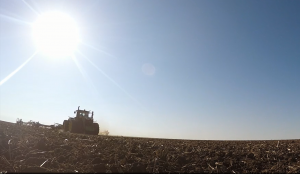
Tim Richter, owner of Saratoga Partnership.
Farming is a tough business. With constantly changing crop prices, difficult to predict and increasingly extreme weather variations, and changing consumer demands, growers don’t have an easy time of it.
Like any business, profitability is the number one priority. And it should be – if you are not profitable, it’s very hard to stay in business.
All the growers I’ve worked with care deeply about their land. In a recent survey of a group of Midwestern farmers, “land stewardship” ranked as their top value. And sustainability is in a farmers’ best interest since healthy lands plays a huge role in whether farms will be around – and productive – for the next generation. But making agriculture truly sustainable will require investment from farmers.
Here’s the good news: sustainability and profitability can go hand-in-hand. Efficiencies like fertilizer optimization can result in cost savings. And with those savings, growers can invest in new technologies and cover crops, which can help make farms more resilient and increase yields, generating long term economic gain.
I asked Tim Richter, owner of a swine and corn farm operation spanning 9,000 acres in northern Iowa and Missouri, to tell me his profitability and sustainability story.
What is your farming story?
I was raised on a farm, and I actually live in the same house that I grew up in – it’s pretty great. I always had farming in my blood, but after three years in the Army, I realized I wanted to be my own boss and be independent. So I used the G.I. Bill to attend Iowa State and graduated with a degree in agronomy. I then went back to the farm and joined my late brother to establish Saratoga Partnership.
What about your sustainability story?
I heard a presentation on sustainability about five years ago and remember thinking “I’m in” as soon as it was over. More than anything, I believe protecting our land is the right thing to do. But becoming more efficient through changes in on-farm practices also segments me from the competition. By changing some of my practices and measuring those adjustments, I’m gaining a real business advantage.
Soon after that presentation, I became involved with The Sustainability Consortium, an organization that works to develop tools that make it easier for companies, governments, farmers and others to implement and track sustainability measures – and efficiencies.
“[Smarter fertilizer management] has paid big dividends. If this is sustainability, I’m on board.”
–Tim Richter, in a Farm Journal story on farming green to get in the black
I also know vegetable producers who’ve had to change their practices due to market considerations over the years. By being able to adopt new technologies, they’ve not only helped the environment but they’ve stayed in business and stayed more profitable.
Is sustainability becoming the new normal in agriculture?
Walmart wants to improve the sustainability of the products in its supply chain, including things like fertilizer optimization and soil conservation in commodity crops. This has big implications for farmers.

Photo Credit: Saratoga Partnership Video. Watch the video here.
If Walmart can make a difference in the sustainability of corn, it will affect the entire supply chain. And the demand for fertilizer-efficient corn will be rampant.
That means farmers will need to invest in sustainability initiatives and technologies for their long-term viability. Putting profits into efficiency and conservation just makes good business sense.
How is technology helping your efforts?
With tools like variable rate technologies I can now look at one plot of 160 acres as 160 one-acre fields. I can manage my crops by acre, to optimize individual parcels. It doesn’t always mean I’ll use less fertilizer, but I’ll be putting it in places where it will result in better yields and less runoff. The more I track, the more I know why certain acres are more profitable than others.
There are also new technologies coming to market every day to help farmers keep nutrients in their fields. They may require near-term investment for long-term gain, but profitability depends on these investments.
Related Links:
More reasons to embrace food sustainability >>
SUSTAIN: navigating the boom in precision ag >>
Campbell’s Soup expands its fertilizer optimization programs >>









